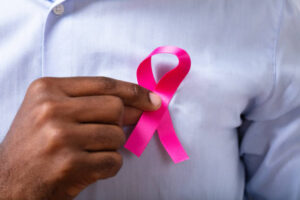Understanding Breast Cancer: Key Facts and Prevention Tips for Early Detection
Categories: Articles,

Courtesy Speakin Out News
According to Breast Cancer Prevention Partners, Black women with breast cancer have a 31% mortality rate, which is higher than any other ethnic group.
Breast cancer incidences are higher in Black women ages 45 and under than White women.
Causes
Many risk factors may increase your chance of developing breast cancer, but it is not yet known exactly how some of these risk factors cause cells to become cancerous. Hormones seem to play a role in many cases of breast cancer, but just how this happens is not fully understood.
Certain changes in DNA can cause normal breast cells to become cancerous. DNA is the chemical in each of our cells that makes up our genes — the instructions for how our cells function. We usually look like our parents because they are the source of our DNA. But DNA affects more than how we look.
Symptoms
Early breast cancer usually doesn’t cause symptoms. But as the tumor grows, it can change how the breast looks or feels. The common changes include:
•A lump or thickening in or near the breast or in the underarm area
•A change in the size or shape of the breast
•Dimpling or puckering in the skin of the breast
•A nipple turned inward into the breast
•Discharge (fluid) from the nipple, especially if it’s bloody
•Scaly, red, or swollen skin on the breast, nipple, or areola (the dark area of skin at the center of the breast). The skin may have ridges or pitting so that it looks like the skin of an orange.
Exams and Tests
Your doctor can check for breast cancer before you have any symptoms. During an office visit, your doctor will ask about your personal and family medical history. You’ll have a physical exam. Your doctor may order one or more imaging tests, such as a mammogram.
Doctors recommend that women have regular clinical breast exams and mammograms to find breast cancer early. Treatment is more likely to work well when breast cancer is detected early.
Tests include:
•Clinical Breast Exam
•Mammogram
•Imaging Tests
•Biopsy
•Lab Tests With Breast Tissue
Treatments
There are many treatment options. The treatment that’s best for one may not be best for another.
The options are surgery, radiation therapy, hormone therapy, chemotherapy, and targeted therapy. You may receive more than one type of treatment.
Surgery and radiation therapy are types of local therapy. They remove or destroy cancer in the breast. Hormone therapy, chemotherapy, and targeted therapy are types of systemic therapy. The drug enters the bloodstream and destroys or controls cancer throughout the body.
The treatment that’s right for you depends mainly on the stage of the cancer, the results of the hormone receptor tests, the result of the HER2/neu test, and your general health.
Possible
Complications
Complications of breast
cancer include:
•Destruction of the breast
•Destruction of the chest
wall surrounding the breast
•Mastitis
•Nipple discharge
•Chest pain
•Radiation therapy side
effects
•Chemotherapy side effects
When to Contact
a Medical
Professional
Contact a doctor right away if you experience any of these warning signs:
•New lump in the breast or underarm (armpit).
•Thickening or swelling of part of the breast.
•Irritation or dimpling of breast skin.
•Redness or flaky skin in the nipple area or the breast.
•Pulling in of the nipple or pain in the nipple area.
•Nipple discharge other than breast milk, including blood.
•Any change in the size or the shape of the breast.
•Pain in any area of the breast.
Preventions
You can help lower your risk of breast cancer in the following ways:
• Get screened for breast cancer regularly. By getting the necessary exams, you can increase your chances of finding out early on, if you have breast cancer.
•Control your weight and exercise. Make healthy choices in the foods you eat and the kinds of drinks you have each day. Stay active.
•Know your family history of breast cancer. If you have a mother, sister, or daughter with breast cancer, ask your doctor what is your risk of getting breast cancer and how you can lower your risk.
•Find out the risks and benefits of hormone replacement therapy. Some women use hormone replacement therapy (HRT) to treat the symptoms of menopause.
•Limit the amount of alcohol you drink.
Natural
Remedies
What changes can you make to reduce your breast cancer risk or ease your treatment? According to research or other evidence, the following self-care steps may be helpful:
What You Need To Know:
Get a checkup
See your healthcare professional once a year for a breast exam and mammogram to detect disease before it becomes advanced
Cut back on cocktails, but not on nutrition
Limit your alcohol consumption and take a multivitamin containing folic acid to reduce alcohol-related breast cancer risk
Eat risk-reducing foods
Add plenty of fiber, tomato products, soy products, and fish to your diet
Prioritize exercise
Maintain a regular exercise program throughout your life
Seek support
If you have breast cancer, join a weekly patients’ group for social support
Mix in melatonin
If you have breast cancer, take 20 mg of this hormone at night under medical supervision to possibly help shrink tumors and slow progression
These recommendations are not comprehensive and are not intended to replace the advice of your doctor or pharmacist.
Photo courtesy NNPA





